What exactly algae is? Algae are protits with same characteristic as plant, but theyre found in aquatic environment. Algae are classified into kingdom of prostite, which means belong to variety or uni cellular and have a cells with membrane bound necleus. Algae also classified as eukaryotic organism which contain chloroplast and able to do photosynthesis. Their range size can be from single cell into very large multi celulllar species and they can live in any type of water, from salt water, fresh water, wet soils, or on most rock. Unlike angiosperms or any higher plants, algae doesnt have any roots, stems, leaves, or flowers. Algae has role as primary producers too in the ocean and thats mean they become food source for some marine organism, such as for shrimp and krill.
Read also:
Majority of algae live in aquatic habitats, which mean they can also endure a range of temperatures , oxygen or carbondioxide concentrations, acidity, and turbidity. As example, there’s giant kelp were found more than 200 meters below the polar ice sheets and another while, there’s green algae which found in very salty environment. Algae also can survive live in land too, and they’re usually grow at animal fur, hot springs, tea trunk, snow banks, and even in deserts. Mostly algae live independently in their various growth forms and they can also live with symbiotic relationships with non-photosynthetic organism too, such as: fungi, spores, and ciliates.
Algae can reproduce themselves by sexually, asexually or by a combination, and that’s means depends on the alternation of generations. There’s main different thing about how they reproduce, which asexually is get reproduce naturally and release spores which maybe motile or non motile. And there are who reproduce sexually, it means produce gametes and its stimulated by environmental factors.
Then, most algae can live for days, weeks, or months and sometime the small one found in abundance during period shorts of the year and remain during the rest of the year. Algae also has some types too and has their own unique characteristic which different from one to another one. And here’s some type of algae you have to know!
1. Cyanobacteria (blue green algae)
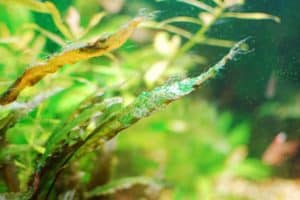
Theyre capable of conducting oxygen-producing photosynthesis and live in some environment like eukaryotic algae, but actually they are gram-negative bacteria and therefore a prokrayotes.
They also capable independently conducting nitrogen fixation, which mean able to converting atmospheric nitrogen to usable element, such as to ammonia.
These bacteria also has pigments that can absorb specific wave lengths of light and give them characteristic colors.
All cyanobacteria have some form of the green pigment cholorophyll, which is responsible for harvesting light energy during photosynthestic process. Because they classified as bacteria, their size quite small and usually unicellular, beside they live in groups until adult. They also known as species which already being the oldest know fossils, because its already exist more than 3,5 billion years ago!
Cyanobacteria are very important organism for the health and grow of many plants, and also can fixed forms of nitrogen which plants need for their growth and most obtain from the saoil. Cyanobacteria also has symbiotic relationships with many fungi, and forming complex symbiotic organism calles as linchens. Cyanobacteria is high in protein and can be cultivated in ponds quite easily. In some tropical countries, its already been important part of diets and was eaten regularly by the Azkeds, which already served into several oriental dishes. However, cyanobacteria also can produce toxic to humans and animals and that’s why is not recommended to eat this thing while we don’t know where exactly they’ve grown up. Not only toxic, its also can caused skin irritation too for some swimmers.
Read also:
2. Chrysophyta
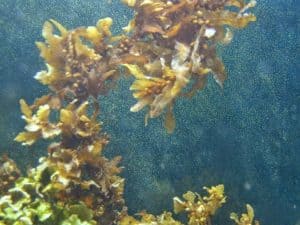 Chrysophyta is common microcopic chromist in fresh water and some species are colorless, but vest majority are photosynthetic. This type are particularly important in lakes too because they become primary food for zoo-plankton.
Chrysophyta is common microcopic chromist in fresh water and some species are colorless, but vest majority are photosynthetic. This type are particularly important in lakes too because they become primary food for zoo-plankton.
Chysophyta classified as plants because they have photosynthetic pigments chlorophyll a and c but the yellow-green algae also contain the carotenoid pigment fucoxanthin. This type will reproduce sexually, but usually they will do reproduction by cell devision.
Chysophyta usually found in fresh water habitats and can live alone as single cells or joined together in colonies, filaments, or thalli.
Chysophyta has enough energy to do photosynthesis, but another creatures usually absorb their energy as food source. Their color mostly brown because their pigment which absorb light called as fucoxanthin. This group usually has one or two golden-brown cells. The cell is surrounded by membranes which contain small amount of silica and most are motile. This type can found easily in ditches, pools, or lakes.
Read also:
3. Euglenophyta
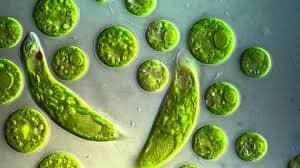
Mostly live in fresh water, and some of them have flagella, and another one not. Outer part of the cell consist of firm but flexible layer such as pellicte or periplast but also considered as cell wall. Some euglena also contain chloroplast which can be used for photosynthetic pigments chlorophyll a and b. The most characteristic genus is Euglena, which easily found in ponds and pools, when the water has been polluted by run off from fields or lown on which fertilizers has been used. There are approxiamately 1,000 species of euglenoids and their reproduction occurs by longitudinal cell division.
The euglenophyta exhibit both plants as well as animal characters because the presence of gullet, holozoic made of nutrition, and the absence of cholorophyl. Meanwhile, they’re classified as algae too because has simplest vegetative body and can do photosynthesis like green plans. But at least we know, euglenophyta is possibility a very primitive organism which apparently closely related to the original both plant and animal kingdoms already evolved.
Euglena are always solitary and never form colonies and usually swimming freeing in fresh water small ponds, especially which rich in organic matter. The shape of euglene sometime spirally twisted and others are colourless at the posterior end. The exterior position is differentiated into soft or less rigid periplast. Their sexual reproduction is by conjugation of amoeboid sogametes.
Read also:
4. Phyroophyta (fire algae)
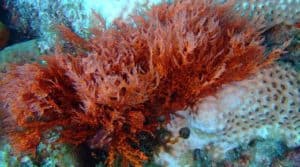 This type have been identified in fossil deposits around the globe, from artic to tropical seas and it means as well in hypersaline waters to river details. This also has variety shapes and sites and the photosynthetic have golden-brown or yellow-green chloroplast. It can synthesize both types of chlorophyl too and contain high levels of carotenoids. If they contact with skin or blooms in closed rooms, it may contaminate humans and cause temporary or more severe neurological diseases.
This type have been identified in fossil deposits around the globe, from artic to tropical seas and it means as well in hypersaline waters to river details. This also has variety shapes and sites and the photosynthetic have golden-brown or yellow-green chloroplast. It can synthesize both types of chlorophyl too and contain high levels of carotenoids. If they contact with skin or blooms in closed rooms, it may contaminate humans and cause temporary or more severe neurological diseases.
Photosynthetic of this type are autotroph, which mean the non-photosytnthetic maybe heterotrophs, existing as parasites and aquatic invertebrates. Some authropic also can feed another uni cellular organism by engulfing them and the species are: sponges, jelly gish, growing coral reefs, anemones, etc. Phyroophyta primarily exhibit asexual cell division, which mean some species reproduce sexually and others have unusual life cycles. They can get nutrition from various ways, such as autotrophy (photosynthesis), heterotrophy (absorption of organic matters), and mixotrophy (autotrophic cells engulf other organism). This type also can be found in some :unique” habitat, such as : living in the plankton, attached to sediments, sand, corals, to macro algal surfaces or to another aquatic plants.
Phyrophyta has a lot negative effects to their environment too, such as when they’re bloom it can be toxic for ocean ecosystems and their consumers. These toxins are carried up the food chain ultimately to humans and can, and sometime results in permanent neurological damage or even death. When phyrophyta blooms, it can caused the water turn into reddish-brown color and known as “red tide”.
Read also:
5. Chlorophyta (green algae)
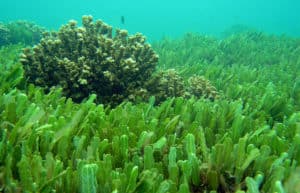
Green algae might be unicellular, multi-cellular, colonial, or coenorcytic. Most green algae are aquatic and can be found easily in fresh water, marine, growing on soil, trees, or rocks. Their reproduction also can be asexual and sexual, which asexual could be fussion (splitting), budding, or fragmentation by zoospores and sexual by isogamous, anisogamous, and oogamous.
Algae base dynamic report that there about 4,500 species of chlorophyta including about 550 species of Trebouxcophycede, 2,500 cholorphycede, 800 species of bryosidophyceae, 400 siphoncalodphyceae, 50 dasycladophyceae, and 250 marine seaweeds. Chlorophyta has various size, from microcopic one to quite large, their color can be various one too because it depends on the dominant chlorophyll pigments, from apple green to blackish green and they get it from chlorophyll a and b. Their over all coloration is determined how much beta-carotene and kantphylls they have like another algae, and they also store their foot as starch. Green algae become important food source too for some herbivorous marine life, such as: crustacean, dishes, and gastropods.
Read also:
6. Rhodophyta (red algae)
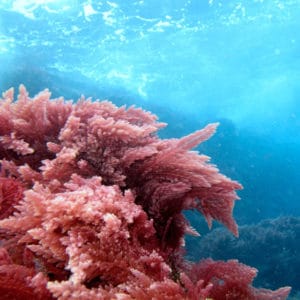
This types of Algae are red because phycoerythin pigment, and his pigment reflects red light and absorb blue lights. Because it has high vitamins and proteins, its become important food source in Asian and this called as nori, which already been consumed since 300 years ago.
Some rhodophytes also important too in formation of tropical reefs, and its already involved more than million years and called as corraline algae, because they secrete hard shell of carbonate around themselves, much the same way that corals do.
This type is large as semblage between 2,500 and 6,000 species in about 670 largerly marine genera that predominate along the coastal and continental shelf areas of tropical, temperature, and cold water regions.
Red algae also become primary producers and also provide structural habits for other marine organism, and have important role in primary establishments and maintenance of coral reefs. Red algae also has important part of their group, called as coralline algae, which for supply calcium carbone into surface of their cells. These carollines also been used for some bone-replacement therapies. Another red algae has been used for another things and best for eaten , such as dulse (palmana palmata), and carrageen moss (chondilus crispus and mastocarpus stellatus). Now a days, red algae kappaphycus and betaphycus are most important source of carrageenan, which is commonly used ingredients in food such as for yoghurt, chocolate, and repared puddings.
7. Paeophyta
 This type is phylum of the kingdom Protista and commonly know as brown algae. Brown algae get their color from presence, in the cell chloroplast of several brownish carotenoid pigments include fucoxanthin as result of photosynthetic pigments chlorophyl a and c. Brown algae are the largest of all algae which may reach a length of over 100 ft.Unlike red and green algae, brown algae are in the Kingdom Chromista.
This type is phylum of the kingdom Protista and commonly know as brown algae. Brown algae get their color from presence, in the cell chloroplast of several brownish carotenoid pigments include fucoxanthin as result of photosynthetic pigments chlorophyl a and c. Brown algae are the largest of all algae which may reach a length of over 100 ft.Unlike red and green algae, brown algae are in the Kingdom Chromista.
Its bit different from another algae from its habitat too because they attached in rock, shell, or dock. We also can found this type easily at inter-tidal zones, near coral reefs and in deeper water such as in 165 deep feet in the Gulf of Mexico.
There are about 1,800 species of brown algae, and the largest and well known is kelp. Another brown algae which commonly known is fucus (rock weeds), or sargassum which known as frominent species in the sargasso sea and its located at North Atlantic Ocean. Brown algae commonly eaten by herbivorous organism such as fish, gastropod, and sea urchins. Brown algae also can be used as food addictive and industry, such as for thickeners, stabilizers, and filters. Phaeophyta are almost entirely marine, frequently dominating rocky shores in cold and temperature waters throughout the world wide.
The giant kelp, Macrosystis pyrifera can found easily in west coast of North America and its can provide habitat and shelter for another organism. We rarely found this type in tropical water and its just only few of that, such as: sargassum and turbinata. The large kelp usually harvested and use as emulsion stabilizer (in product like ice cream), used as fertilizer, or as vitamin source in some food
8. Xantophyta (yellow-green algae)
 Xantophyta is one of Types of Algae include more than 600 species belong to pgotosynthetic organism which live primarily in fresh water, marine water, damp soil, or on tree trunks.
Xantophyta is one of Types of Algae include more than 600 species belong to pgotosynthetic organism which live primarily in fresh water, marine water, damp soil, or on tree trunks.
Unlike another algae, xantophyta is lack of brown pygments, fucoxanthin, and like another cromist they dont have so much chlorophyll b and c too and because that they have yellowish-green color.
Xantophytes maybe free living because most are flayellated unicells, but many are colonial too which living as naked cells in a genelatinous envelope.
Sexual reproduction in this type are known in two genera botrydium (sex cell are isogamous) and vaucheria (the cells are oogamous). Most reproduction is asexual, and this means include fragmentation or flaments of some kind of spores.
After we know about algae and their type, so what exactly the importance of algae in our lives? What advantage we get from them? The most important thing contribution of algae to our environment is we get lot oxygen through photosynthesis and algae are indispensable because they produce about half the oxygen in Earth’s atmosphere. All type of algae also can produce energy-rich oils and naturally accumulate high levels of oil in their dry mass and more over, algae are found in several habitats and can reproduce quickly.
Green algae, diatoms, and cynobacteria are just some microalgal species that’s become good candidates for production of bio-fuel. Now a days, Botryococcus produces algae in Lake Baikal where it releases so much oil into surface of the lake and can be used as source of fuel. Several companies also do this too and grown algae in high-salinity and extract oil as potential alternative to fossil fuels.
Algae also can processed and unprocessed food and sell in high price. Algae extract are commonly used in preparing foods and other products and algae also can be direct consumption for diet of East Asian and Pacific Island. Another one is green algae monostroma and ulva and can be eaten as salads or soups, relishes, meat, or fish dishes.
Read also:
And thats we all know about Types of Algae. Don’t forget to keep our environment clean, because it also affect ocean ecosytems. So, start the change from yourself! 🙂